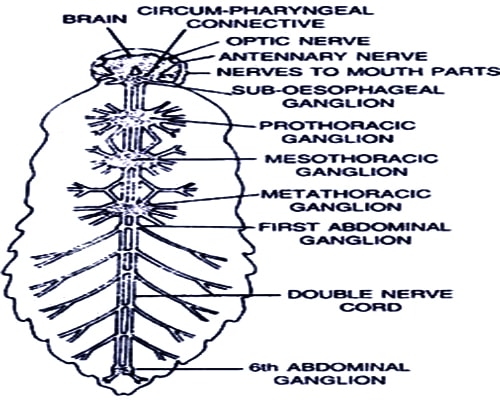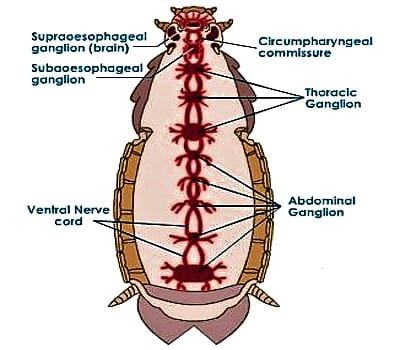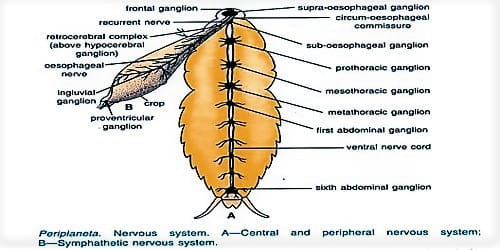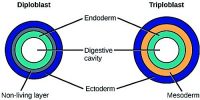The nervous system of cockroach consists of a series of fused, segmentally arranged ganglia joined by paired longitudinal connectives on the ventral side. Three ganglia lie in the thorax, and six in the abdomen. The nervous system of cockroach is spread throughout the body. The head holds a bit of a nervous system while the rest is situated along the ventral (belly-side) part of its body.

Fig: Nervous System of Cockroach
If the head of a cockroach is cut off, it will still live for as long as one week. In the head region, the brain is represented by supra-oesophageal ganglion which supplies nerves to antennae and compound eyes. In cockroach, the sense organs are antennae, eyes, maxillary palps, labial palps, anal cert.’, etc. The compound eyes are situated at the dorsal surface of the head. Each eye consists of about 2000 hexagonal ommatidia (sing.: ommatidium). With the help of several ommatidia, a cockroach can receive several images of an object. This kind of vision is known as a mosaic vision with more sensitivity but less resolution is common during the night (hence called nocturnal vision).
The Nervous System of Cockroach can be dividable into Three Parts:
- The central nervous system,
- The peripheral nervous system,
- Visceral or sympathetic nervous system.
(1) The central nervous system:
The central nervous system consists of the supra-oesophageal ganglion or brain, suboesophageal ganglion, and the nerve cord and circum oesophageal connectives in the head and a double ganglionated ventral .nerve cord in the thorax and abdomen. The brain or supra-oesophageal ganglia are a join up of large, intimately apposed ganglia in the head. It is produced by the fusion of three pairs of ganglia. It represents the brain and is concerned mainly with sensory function. Central Nervous System of Cockroach –

Fig: Central Nervous System of Cockroach
(I) Brain or Supra Oesophageal Ganglion: It is anterior-most ganglionic mass above the esophagus between the supporting apodemes of the tentorium. It comprises of the following components.
- Protocerebrum: Represent the fused ganglia of the acron and preantennal segment.
- Deutocerebrum: It is the second or central part of the brain.
- Tritocerebrum: It is the posterior part of the brain formed by the ganglia of the third or intercalary segment of the head.
(II) Sub-oesophageal Ganglion: It is oval shaped, lines below the esophagus in the head region. It gives off paired nerves supplying their respective appendages.
(III) The Ventral Nerve Cord: Consists of a series of ganglia lying on the floor of thorax and abdomen.
- Thoracic ganglia: The first three ganglia are situated one in each of the thoracic segment called thoracic ganglia.
- Abdominal Ganglia: Six in number, lie in the abdomen.
- Connective: These are two longitudinal cords, joining one pair of ganglia with those preceding and succeeding it.
- Commissures: These are the transverse fibers; unite the pair of ganglia of the system.
(2) Peripheral nervous system:
The peripheral nervous system consists of nerves starting from the ganglia of the central nervous system and supplying to diverse organs in the periphery. The nerves originating from the nerve ring and ventral nerve cord to innervate dissimilar parts of the body compose the peripheral nervous system. From the brain arises a pair of optic and antennary nerves supplying to eyes and antennae correspondingly. Three pairs of nerves originate from the supra-oesophageal ganglion—optic, antennary and labrofrontal nerves. The suboesophageal ganglia supplies paired nerves to mandibles, maxillae, and labium.
(3) Visceral or sympathetic nervous system.
The autonomic or stomatogastric or sympathetic or visceral nervous system of cockroach consists of some ganglia and their connectives. The sympathetic or visceral nervous system consists of a small frontal ganglion in front of the brain dorsal to the pharynx, an oesophageal ganglion on the dorsal side of esophagus and a huge visceral ganglion on the dorsal surface of crop. It includes the frontal, occipital, visceral or ingluvial and pre-ventricular ganglia. The nerves from these ganglia are connected with the supra-oesophageal ganglion.














